实例介绍
【实例简介】微技术可靠性
【实例截图】
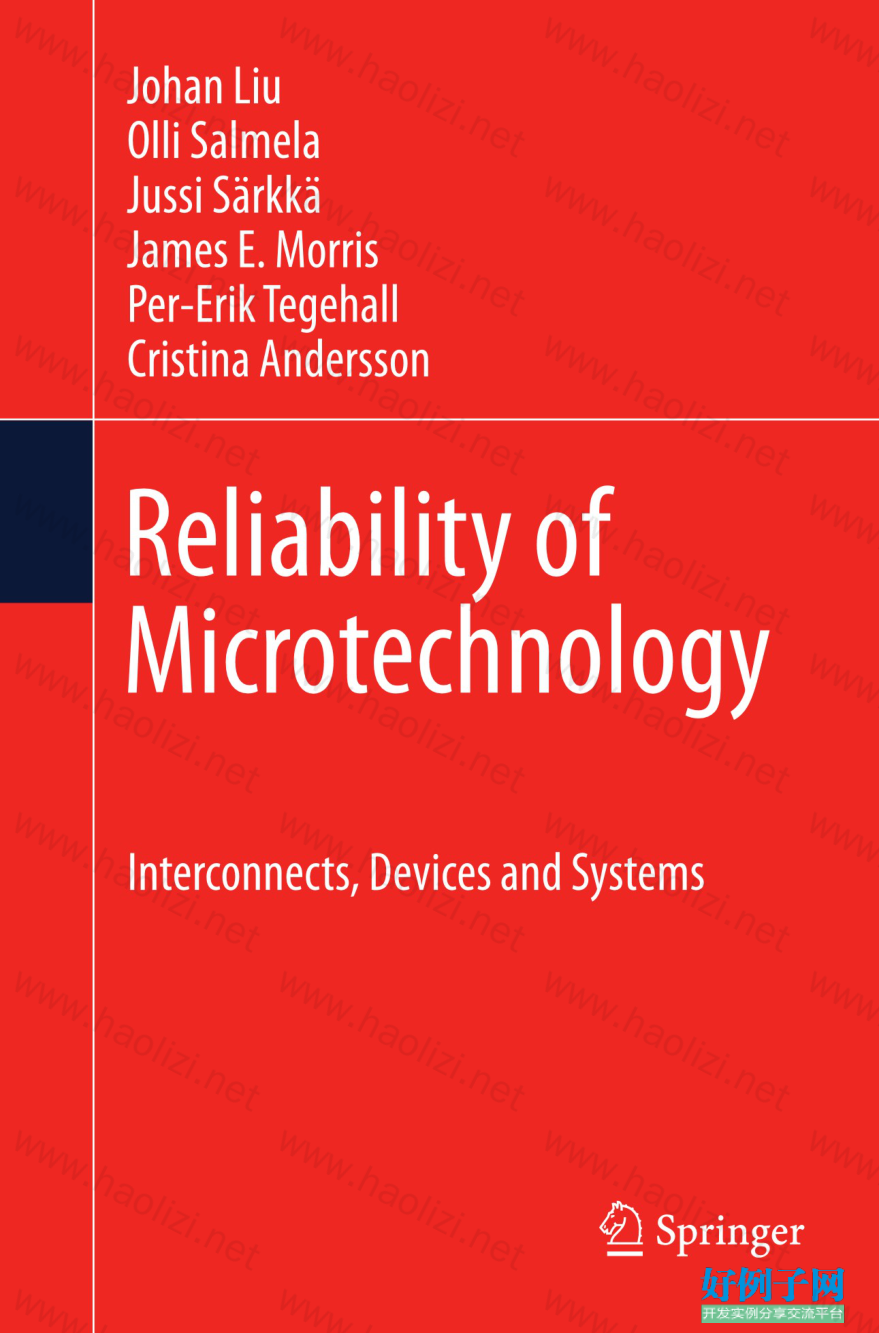
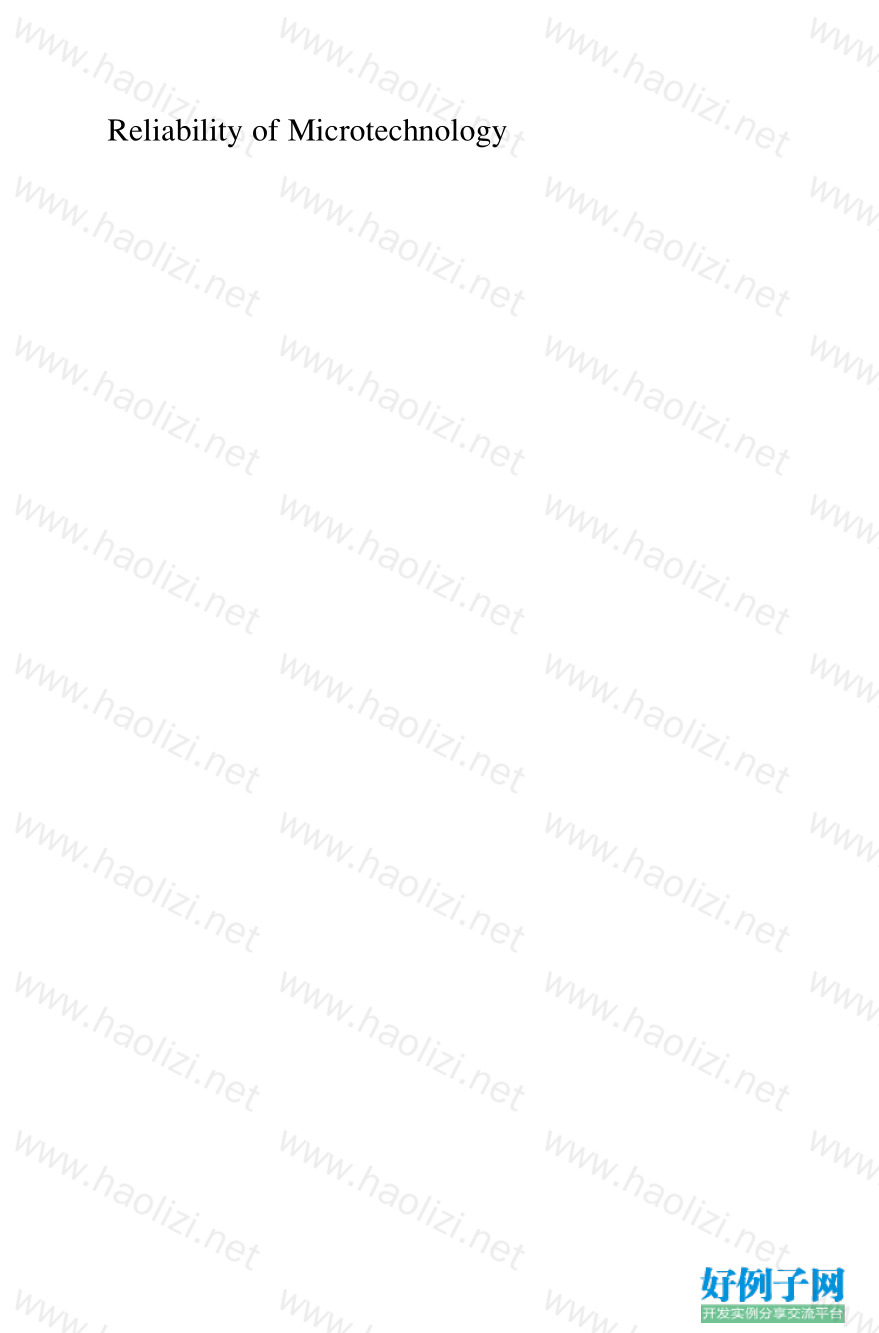


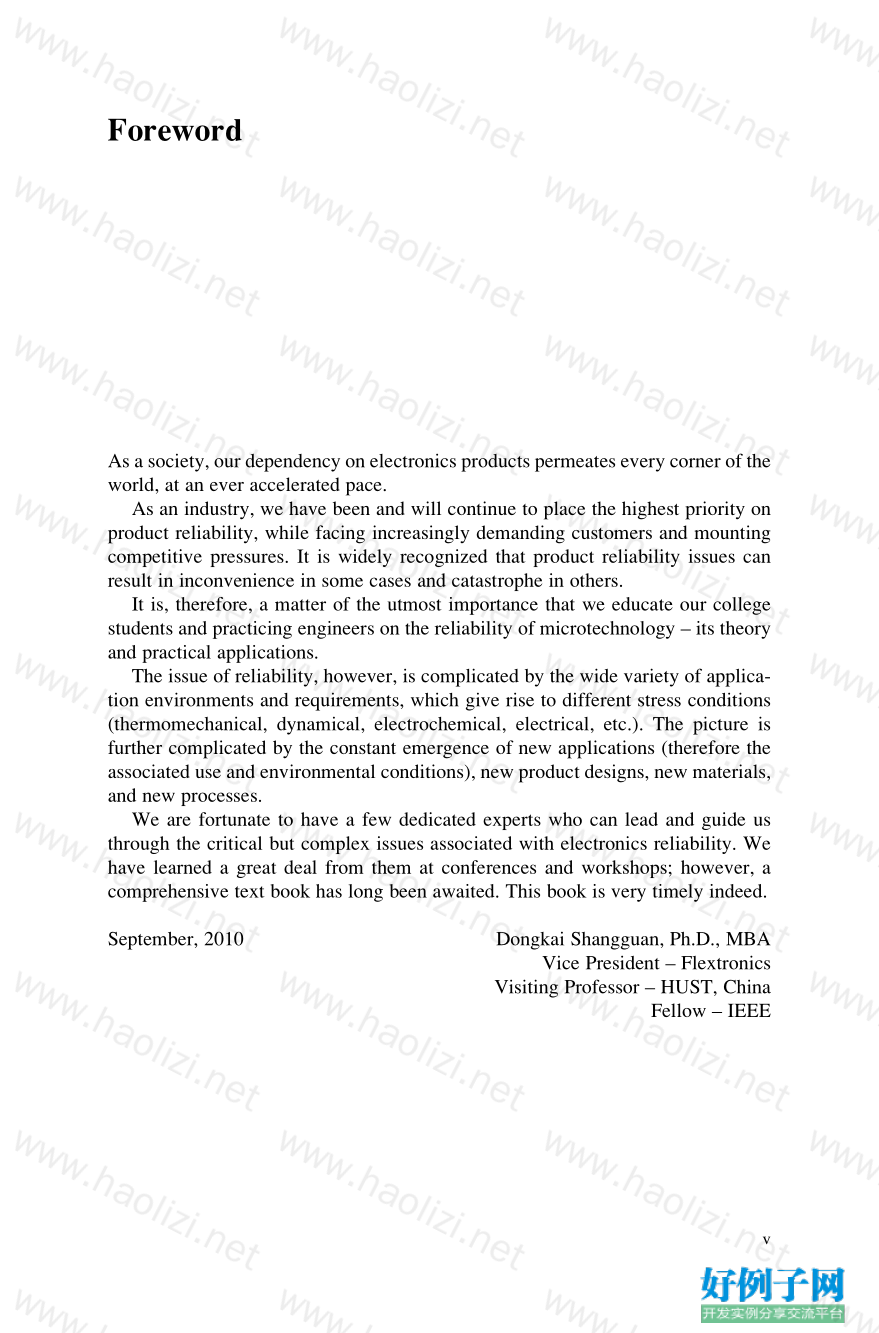
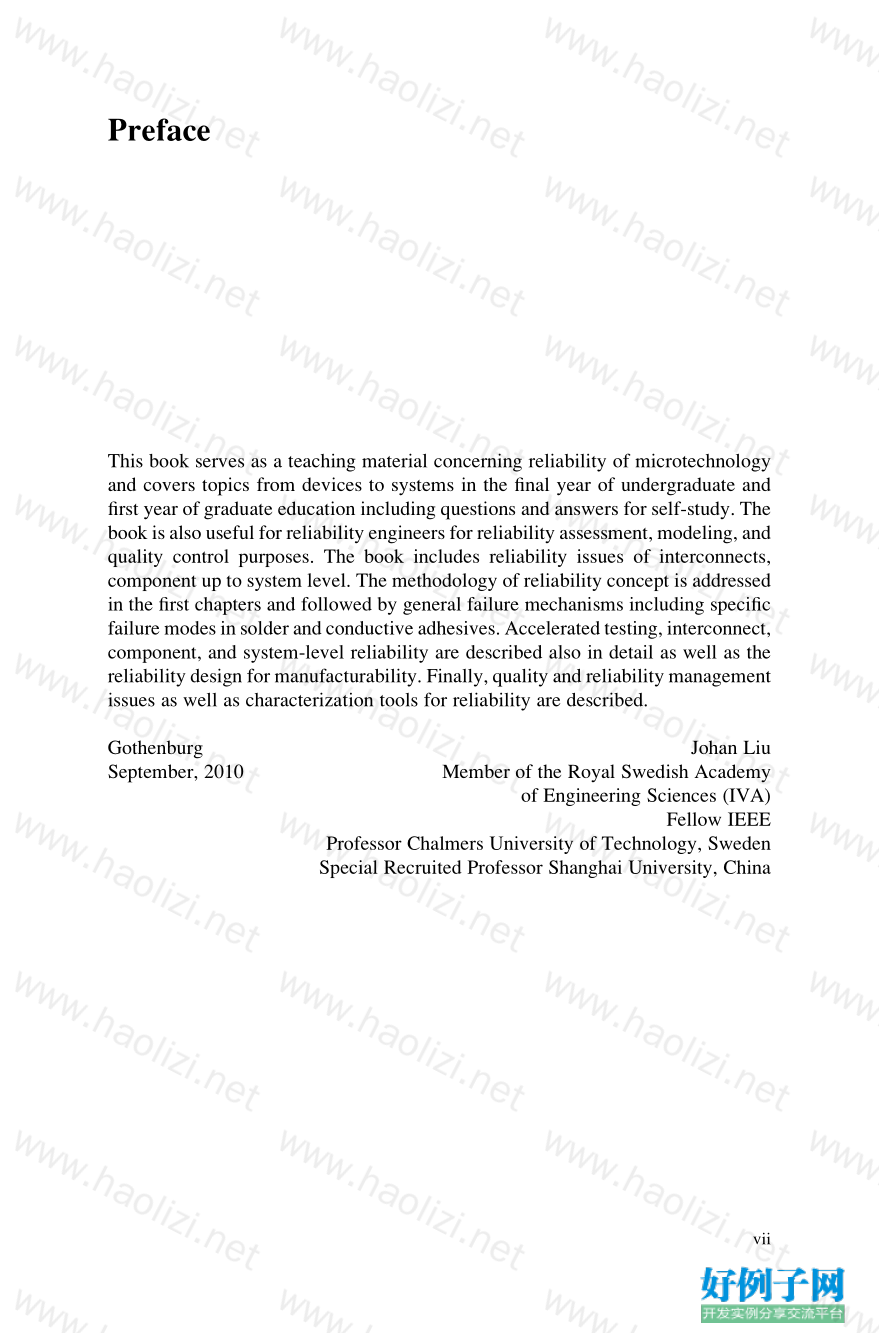
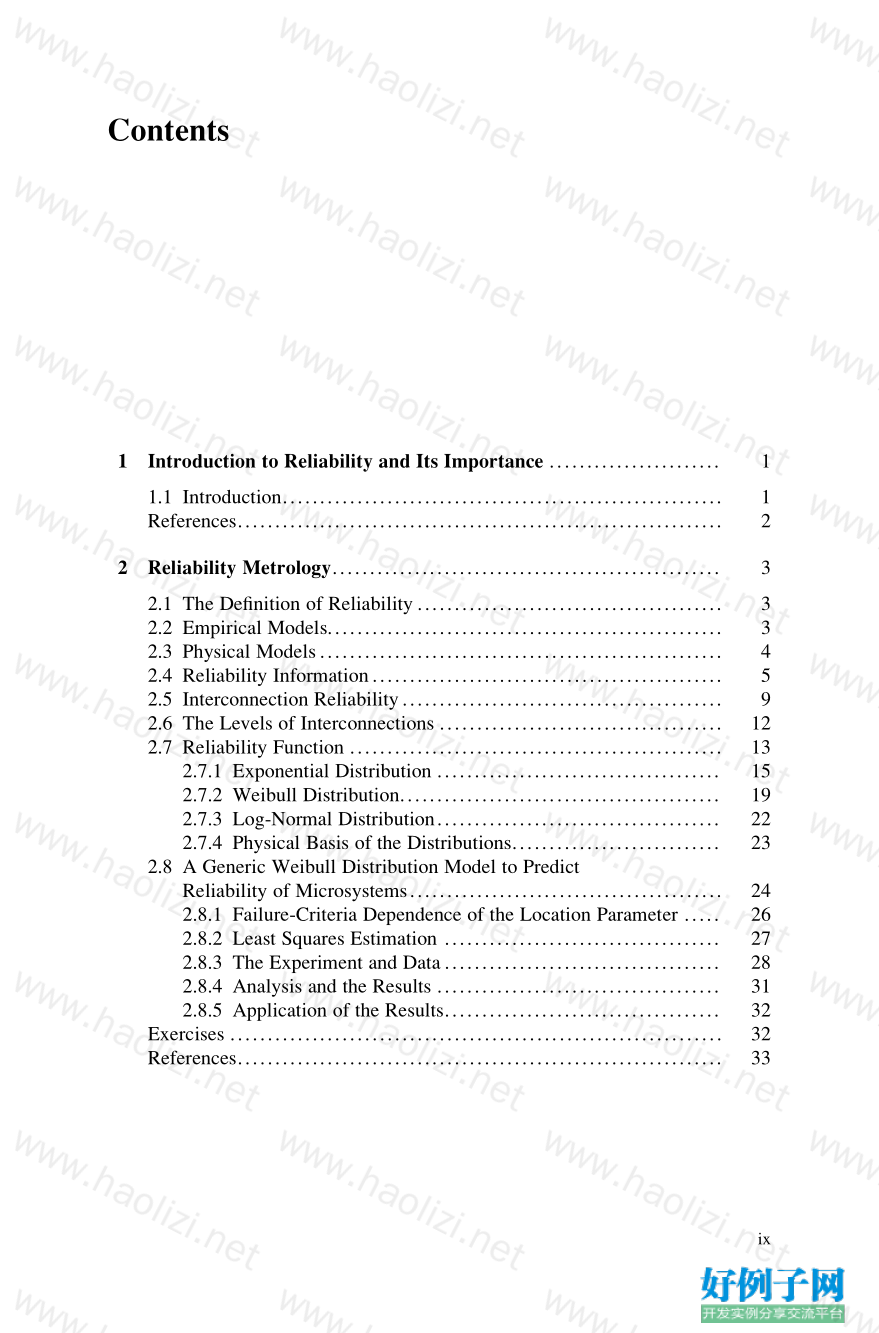
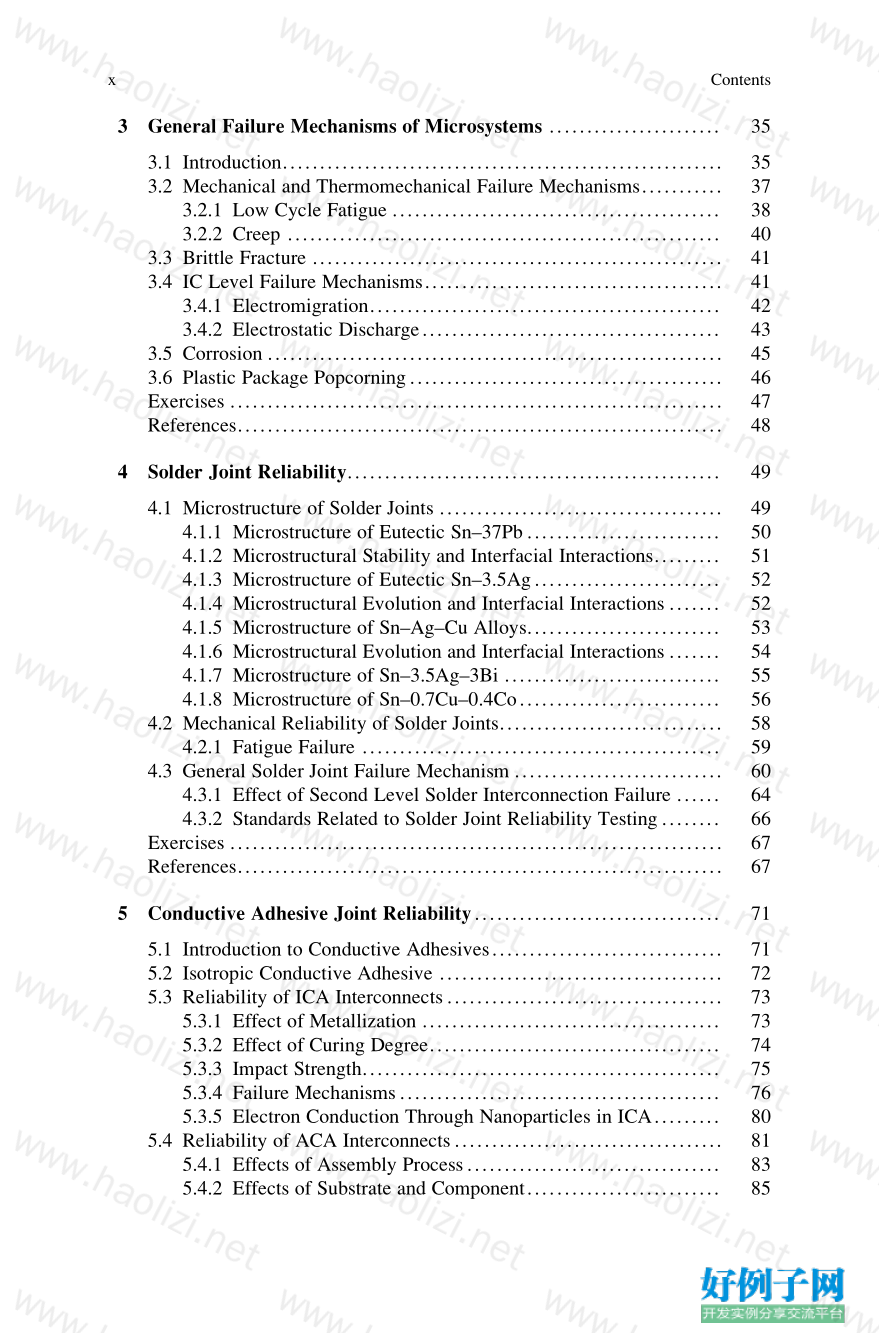
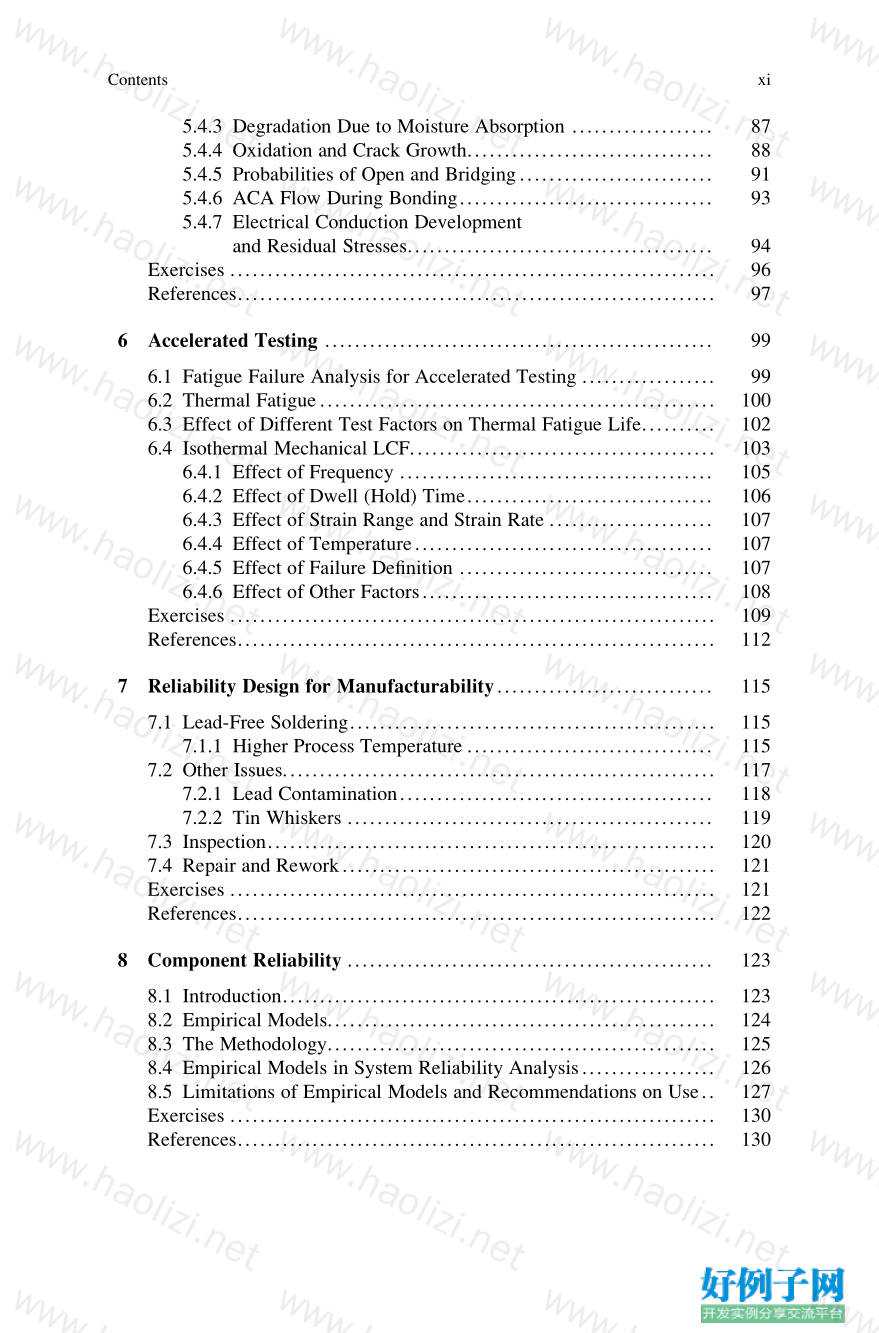

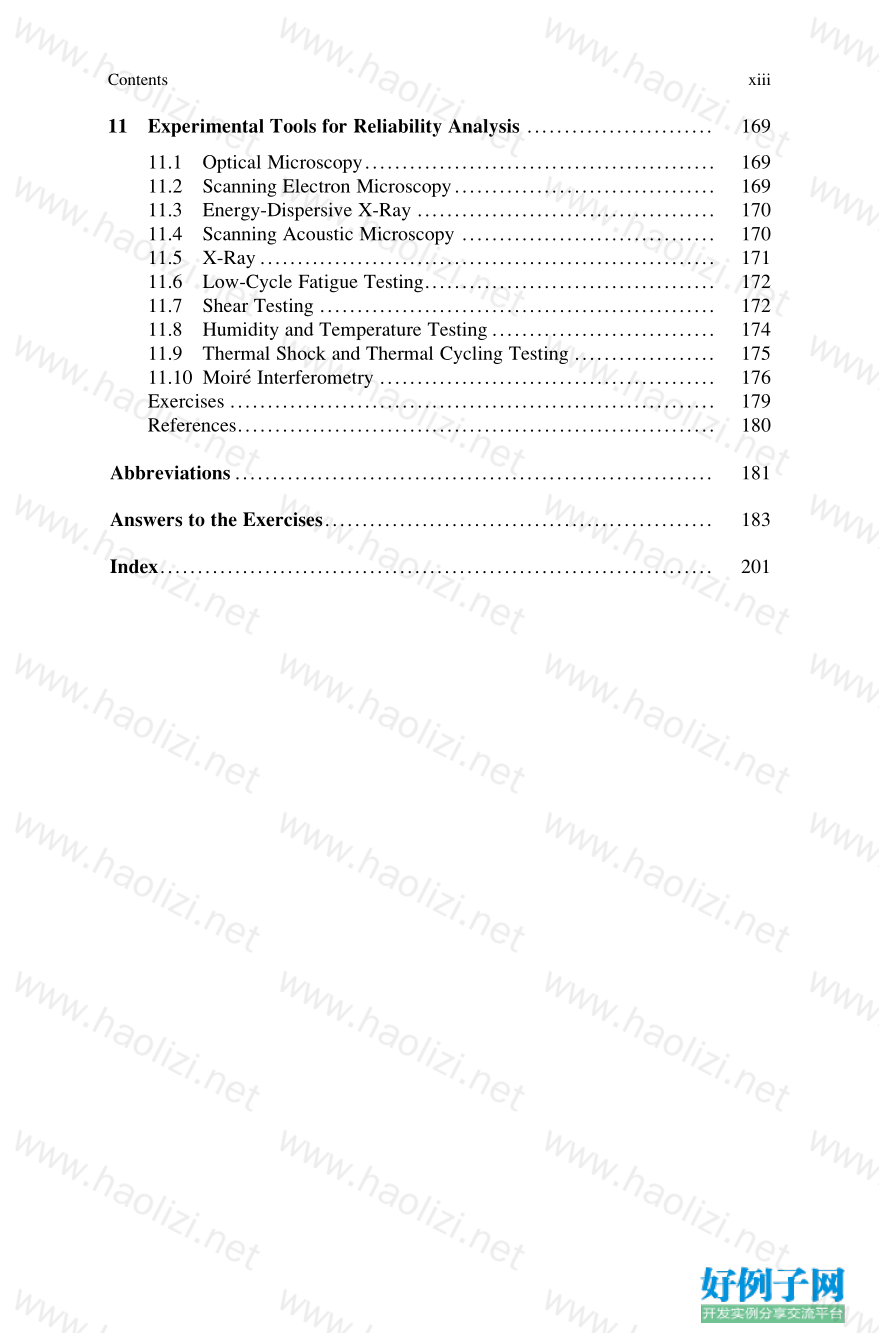
【核心代码】
Contents
1 Introduction to Reliability and Its Importance ....................... 1
1.1 Introduction........................................................... 1
References. . . .............................................................. 2
2 Reliability Metrology.................................................... 3
2.1 The Defifinition of Reliability ......................................... 3
2.2 Empirical Models. .................................................... 3
2.3 Physical Models ...................................................... 4
2.4 Reliability Information ............................................... 5
2.5 Interconnection Reliability ........................................... 9
2.6 The Levels of Interconnections . . . . . . . . . . . . . . . . . . . . . . . . . . . . . . . . . . . . . . 12
2.7 Reliability Function . . . . . . . . . . . . . . . . . . . . . . . . . . . . . . . . . . . . . . . . . . . . . . . . . . 13
2.7.1 Exponential Distribution . . . . . . . . . . . . . . . . . . . . . . . . . . . . . . . . . . . . . . 15
2.7.2 Weibull Distribution. . . . . . . . . . . . . . . . . . . . . . . . . . . . . . . . . . . . . . . . . . . 19
2.7.3 Log-Normal Distribution. . . . . . . . . . . . . . . . . . . . . . . . . . . . . . . . . . . . . . 22
2.7.4 Physical Basis of the Distributions. . . . . . . . . . . . . . . . . . . . . . . . . . . . 23
2.8 A Generic Weibull Distribution Model to Predict
Reliability of Microsystems. . . . . . . . . . . . . . . . . . . . . . . . . . . . . . . . . . . . . . . . . . 24
2.8.1 Failure-Criteria Dependence of the Location Parameter . . . . . 26
2.8.2 Least Squares Estimation . . . . . . . . . . . . . . . . . . . . . . . . . . . . . . . . . . . . . 27
2.8.3 The Experiment and Data . . . . . . . . . . . . . . . . . . . . . . . . . . . . . . . . . . . . . 28
2.8.4 Analysis and the Results . . . . . . . . . . . . . . . . . . . . . . . . . . . . . . . . . . . . . . 31
2.8.5 Application of the Results. . . . . . . . . . . . . . . . . . . . . . . . . . . . . . . . . . . . . 32
Exercises . . . . . . . . . . . . . . . . . . . . . . . . . . . . . . . . . . . . . . . . . . . . . . . . . . . . . . . . . . . . . . . . . . 32
References. . . . . . . . . . . . . . . . . . . . . . . . . . . . . . . . . . . . . . . . . . . . . . . . . . . . . . . . . . . . . . . . . 33
ix3 General Failure Mechanisms of Microsystems . . . . . . . . . . . . . . . . . . . . . . . 35
3.1 Introduction. . . . . . . . . . . . . . . . . . . . . . . . . . . . . . . . . . . . . . . . . . . . . . . . . . . . . . . . . . . 35
3.2 Mechanical and Thermomechanical Failure Mechanisms. . . . . . . . . . . 37
3.2.1 Low Cycle Fatigue . . . . . . . . . . . . . . . . . . . . . . . . . . . . . . . . . . . . . . . . . . . . 38
3.2.2 Creep . . . . . . . . . . . . . . . . . . . . . . . . . . . . . . . . . . . . . . . . . . . . . . . . . . . . . . . . . . 40
3.3 Brittle Fracture . . . . . . . . . . . . . . . . . . . . . . . . . . . . . . . . . . . . . . . . . . . . . . . . . . . . . . . 41
3.4 IC Level Failure Mechanisms. . . . . . . . . . . . . . . . . . . . . . . . . . . . . . . . . . . . . . . . 41
3.4.1 Electromigration. . . . . . . . . . . . . . . . . . . . . . . . . . . . . . . . . . . . . . . . . . . . . . . 42
3.4.2 Electrostatic Discharge . . . . . . . . . . . . . . . . . . . . . . . . . . . . . . . . . . . . . . . . 43
3.5 Corrosion . . . . . . . . . . . . . . . . . . . . . . . . . . . . . . . . . . . . . . . . . . . . . . . . . . . . . . . . . . . . . 45
3.6 Plastic Package Popcorning . . . . . . . . . . . . . . . . . . . . . . . . . . . . . . . . . . . . . . . . . . 46
Exercises . . . . . . . . . . . . . . . . . . . . . . . . . . . . . . . . . . . . . . . . . . . . . . . . . . . . . . . . . . . . . . . . . . 47
References. . . . . . . . . . . . . . . . . . . . . . . . . . . . . . . . . . . . . . . . . . . . . . . . . . . . . . . . . . . . . . . . . 48
4 Solder Joint Reliability. . . . . . . . . . . . . . . . . . . . . . . . . . . . . . . . . . . . . . . . . . . . . . . . . . 49
4.1 Microstructure of Solder Joints . . . . . . . . . . . . . . . . . . . . . . . . . . . . . . . . . . . . . . 49
4.1.1 Microstructure of Eutectic Sn–37Pb . . . . . . . . . . . . . . . . . . . . . . . . . . 50
4.1.2 Microstructural Stability and Interfacial Interactions. . . . . . . . . 51
4.1.3 Microstructure of Eutectic Sn–3.5Ag . . . . . . . . . . . . . . . . . . . . . . . . . 52
4.1.4 Microstructural Evolution and Interfacial Interactions . . . . . . . 52
4.1.5 Microstructure of Sn–Ag–Cu Alloys. . . . . . . . . . . . . . . . . . . . . . . . . . 53
4.1.6 Microstructural Evolution and Interfacial Interactions . . . . . . . 54
4.1.7 Microstructure of Sn–3.5Ag–3Bi . . . . . . . . . . . . . . . . . . . . . . . . . . . . . 55
4.1.8 Microstructure of Sn–0.7Cu–0.4Co . . . . . . . . . . . . . . . . . . . . . . . . . . . 56
4.2 Mechanical Reliability of Solder Joints. . . . . . . . . . . . . . . . . . . . . . . . . . . . . . 58
4.2.1 Fatigue Failure . . . . . . . . . . . . . . . . . . . . . . . . . . . . . . . . . . . . . . . . . . . . . . . . 59
4.3 General Solder Joint Failure Mechanism . . . . . . . . . . . . . . . . . . . . . . . . . . . . 60
4.3.1 Effect of Second Level Solder Interconnection Failure . . . . . . 64
4.3.2 Standards Related to Solder Joint Reliability Testing . . . . . . . . 66
Exercises . . . . . . . . . . . . . . . . . . . . . . . . . . . . . . . . . . . . . . . . . . . . . . . . . . . . . . . . . . . . . . . . . . 67
References. . . . . . . . . . . . . . . . . . . . . . . . . . . . . . . . . . . . . . . . . . . . . . . . . . . . . . . . . . . . . . . . . 67
5 Conductive Adhesive Joint Reliability . . . . . . . . . . . . . . . . . . . . . . . . . . . . . . . . . 71
5.1 Introduction to Conductive Adhesives. . . . . . . . . . . . . . . . . . . . . . . . . . . . . . . 71
5.2 Isotropic Conductive Adhesive . . . . . . . . . . . . . . . . . . . . . . . . . . . . . . . . . . . . . . 72
5.3 Reliability of ICA Interconnects . . . . . . . . . . . . . . . . . . . . . . . . . . . . . . . . . . . . . 73
5.3.1 Effect of Metallization . . . . . . . . . . . . . . . . . . . . . . . . . . . . . . . . . . . . . . . . 73
5.3.2 Effect of Curing Degree. . . . . . . . . . . . . . . . . . . . . . . . . . . . . . . . . . . . . . . 74
5.3.3 Impact Strength. . . . . . . . . . . . . . . . . . . . . . . . . . . . . . . . . . . . . . . . . . . . . . . . 75
5.3.4 Failure Mechanisms . . . . . . . . . . . . . . . . . . . . . . . . . . . . . . . . . . . . . . . . . . . 76
5.3.5 Electron Conduction Through Nanoparticles in ICA. . . . . . . . . 80
5.4 Reliability of ACA Interconnects . . . . . . . . . . . . . . . . . . . . . . . . . . . . . . . . . . . . 81
5.4.1 Effects of Assembly Process. . . . . . . . . . . . . . . . . . . . . . . . . . . . . . . . . . 83
5.4.2 Effects of Substrate and Component. . . . . . . . . . . . . . . . . . . . . . . . . . 85
x
Contents5.4.3 Degradation Due to Moisture Absorption . . . . . . . . . . . . . . . . . . . 87
5.4.4 Oxidation and Crack Growth. . . . . . . . . . . . . . . . . . . . . . . . . . . . . . . . . 88
5.4.5 Probabilities of Open and Bridging . . . . . . . . . . . . . . . . . . . . . . . . . . 91
5.4.6 ACA Flow During Bonding. . . . . . . . . . . . . . . . . . . . . . . . . . . . . . . . . . 93
5.4.7 Electrical Conduction Development
and Residual Stresses. . . . . . . . . . . . . . . . . . . . . . . . . . . . . . . . . . . . . . . . . 94
Exercises . . . . . . . . . . . . . . . . . . . . . . . . . . . . . . . . . . . . . . . . . . . . . . . . . . . . . . . . . . . . . . . . . 96
References. . . . . . . . . . . . . . . . . . . . . . . . . . . . . . . . . . . . . . . . . . . . . . . . . . . . . . . . . . . . . . . . 97
6 Accelerated Testing . . . . . . . . . . . . . . . . . . . . . . . . . . . . . . . . . . . . . . . . . . . . . . . . . . . . 99
6.1 Fatigue Failure Analysis for Accelerated Testing . . . . . . . . . . . . . . . . . . 99
6.2 Thermal Fatigue . . . . . . . . . . . . . . . . . . . . . . . . . . . . . . . . . . . . . . . . . . . . . . . . . . . . . 100
6.3 Effect of Different Test Factors on Thermal Fatigue Life. . . . . . . . . . 102
6.4 Isothermal Mechanical LCF. . . . . . . . . . . . . . . . . . . . . . . . . . . . . . . . . . . . . . . . . 103
6.4.1 Effect of Frequency . . . . . . . . . . . . . . . . . . . . . . . . . . . . . . . . . . . . . . . . . . 105
6.4.2 Effect of Dwell (Hold) Time. . . . . . . . . . . . . . . . . . . . . . . . . . . . . . . . . 106
6.4.3 Effect of Strain Range and Strain Rate . . . . . . . . . . . . . . . . . . . . . . 107
6.4.4 Effect of Temperature . . . . . . . . . . . . . . . . . . . . . . . . . . . . . . . . . . . . . . . . 107
6.4.5 Effect of Failure Defifinition . . . . . . . . . . . . . . . . . . . . . . . . . . . . . . . . . . 107
6.4.6 Effect of Other Factors. . . . . . . . . . . . . . . . . . . . . . . . . . . . . . . . . . . . . . . 108
Exercises . . . . . . . . . . . . . . . . . . . . . . . . . . . . . . . . . . . . . . . . . . . . . . . . . . . . . . . . . . . . . . . . . 109
References. . . . . . . . . . . . . . . . . . . . . . . . . . . . . . . . . . . . . . . . . . . . . . . . . . . . . . . . . . . . . . . . 112
7 Reliability Design for Manufacturability . . . . . . . . . . . . . . . . . . . . . . . . . . . . . 115
7.1 Lead-Free Soldering. . . . . . . . . . . . . . . . . . . . . . . . . . . . . . . . . . . . . . . . . . . . . . . . . 115
7.1.1 Higher Process Temperature . . . . . . . . . . . . . . . . . . . . . . . . . . . . . . . . . 115
7.2 Other Issues. . . . . . . . . . . . . . . . . . . . . . . . . . . . . . . . . . . . . . . . . . . . . . . . . . . . . . . . . . 117
7.2.1 Lead Contamination. . . . . . . . . . . . . . . . . . . . . . . . . . . . . . . . . . . . . . . . . . 118
7.2.2 Tin Whiskers . . . . . . . . . . . . . . . . . . . . . . . . . . . . . . . . . . . . . . . . . . . . . . . . . 119
7.3 Inspection. . . . . . . . . . . . . . . . . . . . . . . . . . . . . . . . . . . . . . . . . . . . . . . . . . . . . . . . . . . . 120
7.4 Repair and Rework . . . . . . . . . . . . . . . . . . . . . . . . . . . . . . . . . . . . . . . . . . . . . . . . . . 121
Exercises . . . . . . . . . . . . . . . . . . . . . . . . . . . . . . . . . . . . . . . . . . . . . . . . . . . . . . . . . . . . . . . . . 121
References. . . . . . . . . . . . . . . . . . . . . . . . . . . . . . . . . . . . . . . . . . . . . . . . . . . . . . . . . . . . . . . . 122
8 Component Reliability . . . . . . . . . . . . . . . . . . . . . . . . . . . . . . . . . . . . . . . . . . . . . . . . . 123
8.1 Introduction. . . . . . . . . . . . . . . . . . . . . . . . . . . . . . . . . . . . . . . . . . . . . . . . . . . . . . . . . . 123
8.2 Empirical Models. . . . . . . . . . . . . . . . . . . . . . . . . . . . . . . . . . . . . . . . . . . . . . . . . . . . 124
8.3 The Methodology. . . . . . . . . . . . . . . . . . . . . . . . . . . . . . . . . . . . . . . . . . . . . . . . . . . . 125
8.4 Empirical Models in System Reliability Analysis. . . . . . . . . . . . . . . . . . 126
8.5 Limitations of Empirical Models and Recommendations on Use . . 127
Exercises . . . . . . . . . . . . . . . . . . . . . . . . . . . . . . . . . . . . . . . . . . . . . . . . . . . . . . . . . . . . . . . . . 130
References. . . . . . . . . . . . . . . . . . . . . . . . . . . . . . . . . . . . . . . . . . . . . . . . . . . . . . . . . . . . . . . . 130
Contents
xi9 System Level Reliability . . . . . . . . . . . . . . . . . . . . . . . . . . . . . . . . . . . . . . . . . . . . . . . 133
9.1 Introduction. . . . . . . . . . . . . . . . . . . . . . . . . . . . . . . . . . . . . . . . . . . . . . . . . . . . . . . . . . 133
9.2 Some Constant Hazard Rate Approximations
of the Weibull Distribution. . . . . . . . . . . . . . . . . . . . . . . . . . . . . . . . . . . . . . . . . . 137
9.3 Resulting Functions and Hazard Rates. . . . . . . . . . . . . . . . . . . . . . . . . . . . . . 140
9.4 Properties of Different Options . . . . . . . . . . . . . . . . . . . . . . . . . . . . . . . . . . . . . 143
9.5 Comparison of the Selected Options. . . . . . . . . . . . . . . . . . . . . . . . . . . . . . . . 145
9.6 Selection of Time Intervals . . . . . . . . . . . . . . . . . . . . . . . . . . . . . . . . . . . . . . . . . 145
9.7 The Motivation for Selecting Two-Parameter
Weibull Distribution. . . . . . . . . . . . . . . . . . . . . . . . . . . . . . . . . . . . . . . . . . . . . . . . . 146
9.8 Constant Failure Rate and Its Origin in the Field Failure Data . . . . 147
Exercises . . . . . . . . . . . . . . . . . . . . . . . . . . . . . . . . . . . . . . . . . . . . . . . . . . . . . . . . . . . . . . . . . 147
References. . . . . . . . . . . . . . . . . . . . . . . . . . . . . . . . . . . . . . . . . . . . . . . . . . . . . . . . . . . . . . . . 148
10 Reliability and Quality Management of Microsystem. . . . . . . . . . . . . . . 149
10.1 Introduction . . . . . . . . . . . . . . . . . . . . . . . . . . . . . . . . . . . . . . . . . . . . . . . . . . . . . . . . 149
10.2 Activity 1: Product Requirements and Constraints. . . . . . . . . . . . . . . . 152
10.3 Activity 2: Product Life-Cycle Conditions . . . . . . . . . . . . . . . . . . . . . . . . 152
10.4 Activity 3: Selection and Characterization of Alternative
Product Architectures and Manufacturing Processes. . . . . . . . . . . . . . 153
10.5 Activity 4: Qualifification of Packaging Concepts
and Manufacturing Processes. . . . . . . . . . . . . . . . . . . . . . . . . . . . . . . . . . . . . . 154
10.5.1 Manufacturability . . . . . . . . . . . . . . . . . . . . . . . . . . . . . . . . . . . . . . . . . . 155
10.5.2 Reliability . . . . . . . . . . . . . . . . . . . . . . . . . . . . . . . . . . . . . . . . . . . . . . . . . . 155
10.5.3 Maintainability . . . . . . . . . . . . . . . . . . . . . . . . . . . . . . . . . . . . . . . . . . . . . 161
10.5.4 Environmental Compatibility . . . . . . . . . . . . . . . . . . . . . . . . . . . . . . 161
10.6 Activity 5: Risk Management and Balance of Functionality,
Quality, and Cost Requirements. . . . . . . . . . . . . . . . . . . . . . . . . . . . . . . . . . . 161
10.6.1 Risk Management of Supplied Materials and Parts . . . . . . . 162
10.6.2 Risk Management of Manufacturing Processes
and New Technologies. . . . . . . . . . . . . . . . . . . . . . . . . . . . . . . . . . . . . 162
10.6.3 Failure Modes and Effects Analysis . . . . . . . . . . . . . . . . . . . . . . . 163
10.6.4 Protective Measures. . . . . . . . . . . . . . . . . . . . . . . . . . . . . . . . . . . . . . . . 163
10.7 Activity 6: Quality Controls and Improvement of Design,
Materials, Parts, and Manufacturing Processes. . . . . . . . . . . . . . . . . . . . 163
10.7.1 Design Defects . . . . . . . . . . . . . . . . . . . . . . . . . . . . . . . . . . . . . . . . . . . . . 164
10.7.2 Defects Caused by Manufacturing Processes. . . . . . . . . . . . . . 165
10.8 Activity 7: Failure Analysis and Feedback
of Gained Knowledge. . . . . . . . . . . . . . . . . . . . . . . . . . . . . . . . . . . . . . . . . . . . . . 167
Exercises . . . . . . . . . . . . . . . . . . . . . . . . . . . . . . . . . . . . . . . . . . . . . . . . . . . . . . . . . . . . . . . . . 167
References. . . . . . . . . . . . . . . . . . . . . . . . . . . . . . . . . . . . . . . . . . . . . . . . . . . . . . . . . . . . . . . . 168
xii
Contents11 Experimental Tools for Reliability Analysis . . . . . . . . . . . . . . . . . . . . . . . . . 169
11.1 Optical Microscopy. . . . . . . . . . . . . . . . . . . . . . . . . . . . . . . . . . . . . . . . . . . . . . . 169
11.2 Scanning Electron Microscopy . . . . . . . . . . . . . . . . . . . . . . . . . . . . . . . . . . . 169
11.3 Energy-Dispersive X-Ray . . . . . . . . . . . . . . . . . . . . . . . . . . . . . . . . . . . . . . . . 170
11.4 Scanning Acoustic Microscopy . . . . . . . . . . . . . . . . . . . . . . . . . . . . . . . . . . 170
11.5 X-Ray . . . . . . . . . . . . . . . . . . . . . . . . . . . . . . . . . . . . . . . . . . . . . . . . . . . . . . . . . . . . . 171
11.6 Low-Cycle Fatigue Testing. . . . . . . . . . . . . . . . . . . . . . . . . . . . . . . . . . . . . . . 172
11.7 Shear Testing . . . . . . . . . . . . . . . . . . . . . . . . . . . . . . . . . . . . . . . . . . . . . . . . . . . . . 172
11.8 Humidity and Temperature Testing . . . . . . . . . . . . . . . . . . . . . . . . . . . . . . 174
11.9 Thermal Shock and Thermal Cycling Testing . . . . . . . . . . . . . . . . . . . 175
11.10 Moire
´ Interferometry . . . . . . . . . . . . . . . . . . . . . . . . . . . . . . . . . . . . . . . . . . . . . 176
Exercises . . . . . . . . . . . . . . . . . . . . . . . . . . . . . . . . . . . . . . . . . . . . . . . . . . . . . . . . . . . . . . . . . 179
References. . . . . . . . . . . . . . . . . . . . . . . . . . . . . . . . . . . . . . . . . . . . . . . . . . . . . . . . . . . . . . . . 180
Abbreviations . . . . . . . . . . . . . . . . . . . . . . . . . . . . . . . . . . . . . . . . . . . . . . . . . . . . . . . . . . . . . . . . 181
Answers to the Exercises. . . . . . . . . . . . . . . . . . . . . . . . . . . . . . . . . . . . . . . . . . . . . . . . . . . . 183
Index. . . . . . . . . . . . . . . . . . . . . . . . . . . . . . . . . . . . . . . . . . . . . . . . . . . . . . . . . . . . . . . . . . . . . . . . . . 201
好例子网口号:伸出你的我的手 — 分享!
小贴士
感谢您为本站写下的评论,您的评论对其它用户来说具有重要的参考价值,所以请认真填写。
- 类似“顶”、“沙发”之类没有营养的文字,对勤劳贡献的楼主来说是令人沮丧的反馈信息。
- 相信您也不想看到一排文字/表情墙,所以请不要反馈意义不大的重复字符,也请尽量不要纯表情的回复。
- 提问之前请再仔细看一遍楼主的说明,或许是您遗漏了。
- 请勿到处挖坑绊人、招贴广告。既占空间让人厌烦,又没人会搭理,于人于己都无利。
关于好例子网
本站旨在为广大IT学习爱好者提供一个非营利性互相学习交流分享平台。本站所有资源都可以被免费获取学习研究。本站资源来自网友分享,对搜索内容的合法性不具有预见性、识别性、控制性,仅供学习研究,请务必在下载后24小时内给予删除,不得用于其他任何用途,否则后果自负。基于互联网的特殊性,平台无法对用户传输的作品、信息、内容的权属或合法性、安全性、合规性、真实性、科学性、完整权、有效性等进行实质审查;无论平台是否已进行审查,用户均应自行承担因其传输的作品、信息、内容而可能或已经产生的侵权或权属纠纷等法律责任。本站所有资源不代表本站的观点或立场,基于网友分享,根据中国法律《信息网络传播权保护条例》第二十二与二十三条之规定,若资源存在侵权或相关问题请联系本站客服人员,点此联系我们。关于更多版权及免责申明参见 版权及免责申明



网友评论
我要评论